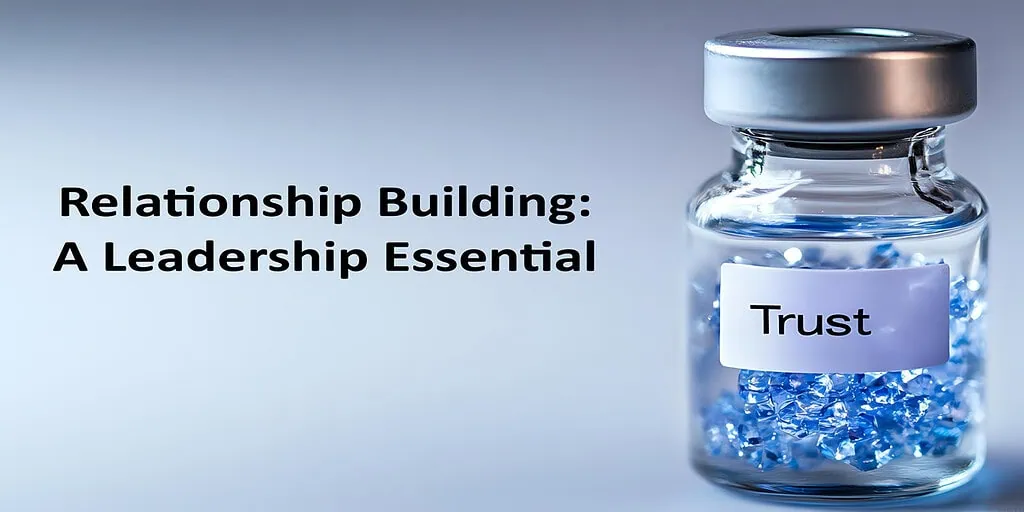Article Contents:
Relationship Building:
Relationship Building—a leadership trait that quietly powers trust, collaboration, and long-term influence.
In this article, let us explore what is relationship building is all about and effective leaders build it by balancing performance and relationship in the workplace.
What is Relationship Building in Leadership?
Relationship building is about creating genuine human connections based on mutual respect, emotional safety, and consistent presence.
It is when people feel seen, heard, and valued, not just for what they deliver, but for who they are.
In leadership, especially in small businesses, this means being intentional in your interactions. It means showing up beyond transactions—asking how someone is doing, acknowledging their effort, inviting their perspective, and being consistent in tone and behavior.
When you build relationships like this, people feel safe. They share more, align better, and take greater ownership of their responsibilities.
What Relationship Building is Not?
It is not about being overly friendly or constantly available.
It is not about pleasing everyone or avoiding difficult conversations.
And it is not about the number of contacts you have in your mobile contact list or on social media platforms like LinkedIn, Facebook, or Instagram.
For example, I have over 3,500+ connections on LinkedIn, but I don’t know around 80% of them. Like many professionals, I accepted requests as they came. But I often ask myself—how many of these are genuine relationships?
Authentic relationships are not measured in numbers, but in depth, mutual understanding, and earned trust.
A Small but Powerful Shift
I once worked with a founder who shifted from issuing instructions to simply asking, “What do you think we can do here?”
It seemed small, but it changed the culture. Over time, people felt invited, trusted, and engaged. That single behavior became the foundation of stronger relationships across the team in his organization.
Reflect: Are you building genuine relationships only to get work done, or to create something that outlasts your presence?
Building Relationships through Consistency
People don’t trust you because of your position; they trust you because of your behavior over time.
Trust is what makes people feel safe, heard, and valued. And in professional environments, where collaboration, speed, and ownership matter every day, trust isn’t optional—it is essential.
Consistency is where trust is earned.
For example, if you tell your team that the P&L will be reviewed every month before the 10th, and you consistently do so, you are not just completing a task—you are demonstrating reliability. That consistency builds trust.
Similarly, if you regularly update your team on business performance and customer feedback without filters, you build trust in your openness. Over time, people stop second-guessing leadership. They begin to believe in it.
Consistency in behavior → builds Trust → deepens Relationships → increases Influence.
Without consistency, even capable leaders leave people feeling uncertain. And uncertainty weakens the connection.
Reflect: Do your people trust you because of what they consistently experience, or are they still unsure of how you will show up tomorrow?
Habits that Break Relationships
If relationship-building is simple, why do many leaders still struggle? It is rarely intent—it’s the silent creep of habits, pressure, pace, or ego.
Staying Detached
Some leaders carry beliefs from early experiences: “Stay professional, don’t get too close.” Or, “If I become too approachable, I may lose control.”
So they keep a safe distance, without realizing that the gap creates hesitation. People start to hold back because they are unsure how you will respond.
Speed and Pressure
In fast-paced work environments, leaders are constantly solving problems and meeting deadlines.
In this mode, conversations become short and task-oriented. You speak to get work done, not to connect. Over time, people stop bringing things that don’t look urgent, even if they are important. Relationships get reduced to instructions.
Ego Disguised as Efficiency
Some leaders say, “You should already know what is expected,” without guiding or teaching what is needed. Others say, “I don’t need to explain every detail,” or “I will wait for them to come to me.”
Such expressions may sound efficient, but they slowly weaken trust. Leadership is not just about being right; it’s about being reachable.
Most relationships don’t collapse due to one big event. They drift apart through repeated silences and small breaches of trust.
Reflect: Are you creating distance while believing you’re staying efficient?
Relationships Grow with Intention
How do leaders consciously build and nurture relationships every day?
Presence
Relationship building isn’t a separate task; it is a way of showing up.
When you pause to ask, “How are things going for you?” with genuine intent, people feel seen and valued.
When you share what’s happening in the business without being asked, they feel trusted.
When you ask, “What do you think?”, they feel included.
These are not dramatic moves. They are small, consistent behaviours that send a powerful message: You matter to me.
Help without Agenda
Years ago, during my tenure in a senior leadership role, a colleague from another company requested support for a plant visit for their team.
There was no obligation, and it meant extra coordination. But without thinking twice, I said yes and ensured the visit was smooth and meaningful.
At that moment, it felt like a simple courtesy. But over time, that gesture became the foundation for a long-lasting relationship.
When you offer help without expecting anything in return, the value often goes beyond the moment. People may not remember the task, but they remember your intent when they need it.
Daily Routines
I recall a colleague who had a simple yet powerful habit. He used to arrive early and walk around, greeting his team and colleagues with a warm “Hi” or “Good morning.”
On the surface, it looked like a friendly routine. Over time, that simple walk gave him valuable ground-level insights for his supply chain role. More importantly, it made people feel comfortable. They proactively shared updates or flagged potential issues because they trusted him.
That was his way of building trust—not through formal reviews, but through small, daily gestures.
Reflect: Are you waiting for the right time to build relationships, or using the time you already have with intention?
Sustaining Professional Relationships
Building is one part; sustaining is where leadership matures.
During Growth
As responsibilities expand, many leaders unintentionally grow distant. People may start to feel unseen, not because of intent, but because of silence.
I remember my ex-boss, who, despite handling multiple priorities, never missed his weekly 30-minute coffee meeting every Wednesday. It was not about reporting. It was about staying connected. That rhythm made everyone feel included and reminded us that growth did not change his presence.
During Conflict
Disagreements are part of leadership. But when handled with respect, they strengthen relationships. Leaders who say, “Let us explore both views,” instead of pushing their stand, preserve trust even in conflict.
During Underperformance
It’s easy to stay connected with top performers. Strugglers need you just as much. A short one-on-one conversation can do more than a formal warning. People remember how you made them feel during tough times.
Reflect: As your role evolves, are you staying emotionally present, or are relationships quietly fading?
Balancing Performance and Relationship
A real leadership dilemma: Can I be approachable and still drive performance?
Leaders often swing between extremes—too soft to avoid discomfort, or too formal to maintain authority. But leadership is not either-or. It is about balancing both.
How Effective Leaders Demonstrate Balance
- Set expectations with empathy and firmness: “This week’s delivery is critical. What support do you need to get it right?”
- Give feedback that respects the person: “Your effort is not in doubt. But the outcome needs work. Let’s improve it together.”
- Acknowledge hardships without lowering standards: “I know things are hard. Let’s agree on what you can commit to this week.”
Balancing requires awareness of responsibilities in both results and relationships. Leaders are measured not just by what they deliver, but by how they deliver it.
Reflect: Are you leaning too much on results or relationships, at the cost of the other?
Summary – Building Relationships
Over the past reflections, we have seen that relationship-building is a leadership behavior that defines influence and culture.
- Relationships grow with intent: Built through presence, small gestures, and daily routines.
- What weakens them: Pace, pressure, ego, and silence.
- How they strengthen: Helping without agenda, consistency, and accessibility.
- How they sustain: Staying present during growth, conflict, and performance challenges.
- How they balance: Holding accountability with humanity, driving results while building trust.
The core insight: You are measured not just by results, but by how you carry people along the journey.



